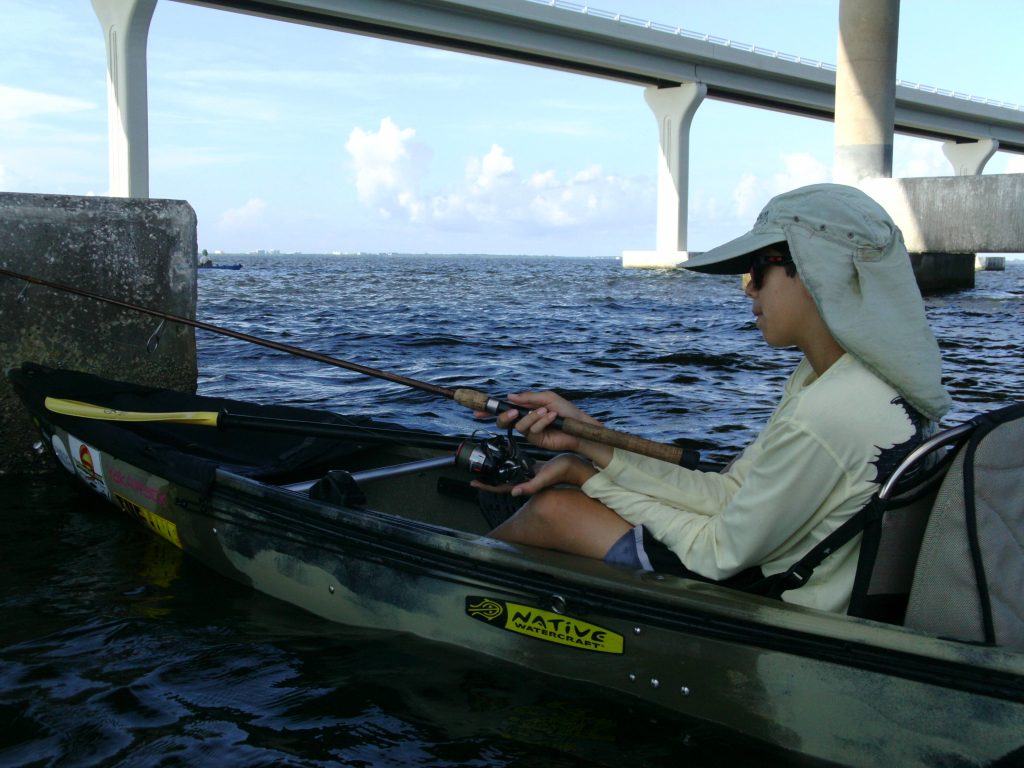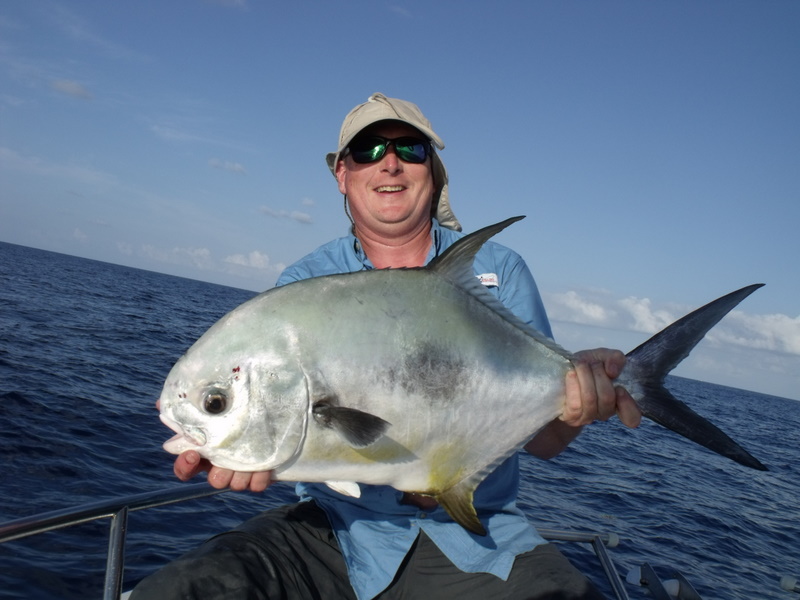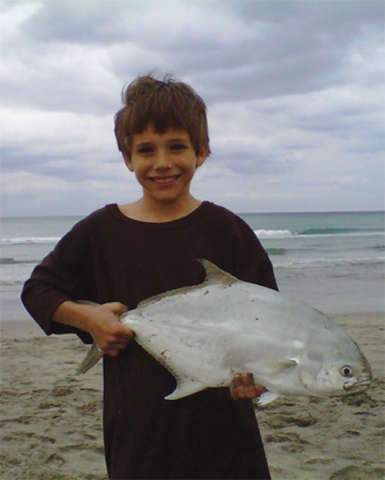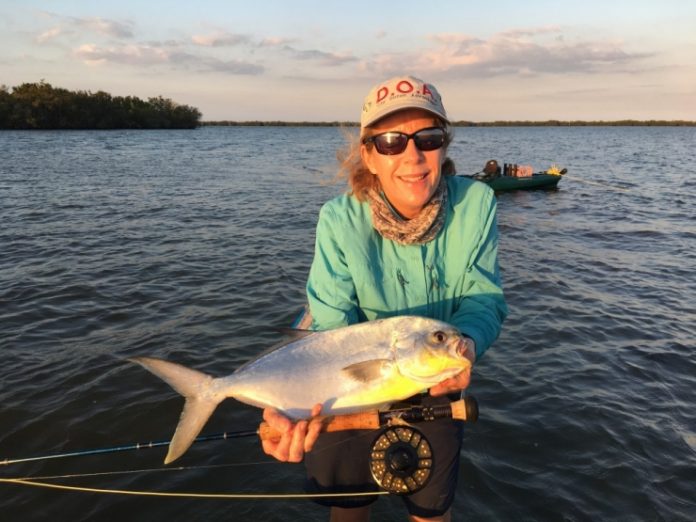By Neil Taylor
Owner: Capmel.com
Owner and Guide: Strike Three Kayak Fishing Livelybaits@aol.com
Learn about Pompano.
The Pompano is a feisty species that puts up a terrific fight on light tackle. The Pompano belongs to the same family as the Permit. It has a short snout with small teeth. Coloring is white to silver with some yellow mixed in. A “meaty” fish, they make for a great fish to bring back to the house. I have published many articles on pompano. This one draws it all together. I am a pompano junkie. As guides go, there’s me and there is Captain Scott Moore. Other guides catch pompano on accident. Scott and I take pompano trips.
The Pompano is fine eating and a hard fighting fish. It is believed by many to be the world’s most exciting light tackle gamefish. It enters shallow water and can be taken from beaches, piers, jetties, troughs and bridges. Most pompano are caught, around Tampa Bay, in water 9 to 12 feet deep. One in five you hook will make a leap.
Eating: Great alone, I smoke them and make a premium fish spread. Eliminates removing the skin. Once smoked, the meat peels away from the skin so easily. It is such firm, great meat. Want to try fish spread? Instructions
Decent size, most pompano average about 2 pounds. The Florida record is 8 pounds 4 ounces, caught on a Mirrolure at Port St Joe.
Pompano are found in the tropical waters of the western Atlantic with water temperatures in the 81 -89° F range.
Pompano can be found throughout the coastal areas of Florida. On the Atlantic coast they are most prevalent from New Smyrna south to Miami and are targeted “in the surf” most of the time. The best times of the year are between October to December and again April to July.
Pompano can also be caught along the entire West Coast of Florida. Especially between St. Petersburg to 10,000 Islands. Pompano can be caught in the Panhandle region all summer.
In the dead of winter, pompano evacuate Tampa Bay. To catch pompano, drive down to Sarasota Bay or south of there. The pompano of summer in Tampa Bay are down south in the wintertime.
Locating and catching this species: They can be caught by surfcasting, flyfishing, “jigging”, or spincasting from shore or from a boat. The most preferred way of targeting pompano is with “the jig and teaser.” The veteran pompano guy is usually going to be using this outfit. A pompano jig, light to medium light weight (yellow) and a teaser fly. This is a small fly and the preferred color is pink with “flash.” The safety speech on the jig and teaser, you have to be careful of that second hook. Using pliers helps keep your hands safely away from the second hook. Pompano are slippery. Among the toughest to hold, I pin the fish against my leg to remove the hook from its mouth.
Teasers:
On “color”, I believe that there is a trend. Stick with yellow, gold and silver “flash” such as “lateral scale.” My personal pompano rig is always, yellow jig and pink teaser. But other metallic and yellow/gold colors will work to get pompano to eat.
There are “structure pompano” and wide open water pompano. Structure pompano: That is your bridge fishing. Tough on windy days, you have to stay “on the pilings” to catch them. Drop jigs right next to the structure. Open water situations, make long casts and work the jig minimum speed to have it on the bottom at all times.
This is aggressive to the structure.

Fishing Equipment:
Spinning gear should include a 7′ medium action rod and reel with 6# -12 # test line.
For the Atlantic guys: Surfcasting gear should include an 8′ to14′ surf rod and reel capable of heaving 6 to 8-ounce sinkers with 20# to 30# line.
Flyfishing gear should include a 8-1/2′ to 9′ long 7 weight rod with a reel holding 100 or more yards of 20# backing. 25# leader is a good choice because often, where there’s pompano, there’s ladyfish. 20# leader doesn’t hold up as well with the ladyfish. This applies to your spincasting for pompano as well. 30# leader is good but 25# is my standard fluorocarbon leader choice.
Pompano technique
expanded:
Jigging and Jiggling
There are many ways to fish for pompano and you have a good chance of catching them if you just use your common sense and have a little knowledge about their habits. If you have a skiff, you can find pompano schools pretty easily. Move along the beaches, close to the swash channel, at full speed and have someone watch your wake for pompano “skipping”. They will jump out of the water when spooked and skip along the surface. Immediately turn around and stop the boat so you can work that area. Remember that pompano are schooling fish and where you see one, there are always a lot more. “Pompano will come to you.” If you are in the right locations. For the bridge and pier anglers, and just cast your lure or bait all day until a school swims in and you hook up. If you know that pompano love sand fleas, small crabs and other mollusks, you will fish along beaches where there is an abundance of sand fleas. Bridge pilings are another great place to fish for them, where the barnacles have built up over the years and there are a lot of small crabs, shrimp and other shellfish living among the barnacle growth. When fishing these areas, it doesn’t hurt to use a shovel or hoe to scrape the barnacles off the pilings to create a great chum line. You’ll be surprised at what you will attract in this manner. Other places to hunt for pompano are around the mouths of passes, particularly those with a drop off or shell bottom near the mouth of the pass. Pass-a-Grille is the prime example in our area, with a large, shallow sandy spoil outside the pass dropping off 18 feet to a hard shell bottom just inside the pass. A Gulf “pass”, this is an ideal spot to fish an incoming tide since the pompano and other game fish will be in the deeper water waiting for the tide to wash sand fleas, crabs, and other tasty morsels over the ledge to their waiting mouths. On the outgoing tide you can frequently find the pompano on the top of the spoils rooting around for sand fleas etc. Most passes have pompano opportunities.
Pompano have a close relative, called a permit. When the permit and pompano are small, they will frequently school together. Their appearance is so similar that the state has made the size regulations the same for pompano and permit. They can be kept no less than 11. You are allowed to keep 6 per person per day. They are in the jack family and many people mistake them for jacks and throw them back. For Permit: You can keep two. Not less than 11″ or more than 22″ fork length; may possess 1 over 22″ included in the per person bag limit.
The Permit:

Another close one: The palometa. Very similar to the pompano but it is smaller and has very long fins.
Jigs, the old reliable is a ¼ to ½ ounce yellow or white bullet-headed jig wrapped with the same color hair cut off at the bend of the hook. There are other patterns that are good. You want to bounce every jig off the bottom creating a puff of sand that looks like a crab trying to bury itself. This will trigger a strike from a pompano. Just be sure when using a hair type jig that you cut off the hair at the bend of the hook. Pompano are to the point and you will miss more of them if your teasers or your jigs are “too long”.
Baits
Natural baits including fiddler crabs, clams, sand fleas, blood worms and shrimp work well. Artificial lures which produce are jigs with yellow and yellow combination nylon hair, bucktails, the jig/teaser mentioned above and plastic tailed jigs. Fish them on the bottom with a weight small enough to hold them down but not so big as to hinder the movement along the bottom with the current. Like any bait fishing, use sufficient weight to get it to where the pompano are. Don’t go too light. Don’t go too heavy.
To me, pompano are an underutilized species, which is good in many ways. Most fishermen just don’t go for pompano. If they did, I’d be selling more teasers. It is a miss. They are so good to keep but they are fun to catch. Their fighting power, better than average, catching pompano is just basically a great deal of fun.
My website has dozens of articles on my pompano trips. Using the search feature and the word “pompano”, here is what comes up- POMPANO
The jig and teaser catches so much. Silver trout. Whiting. Spanish mackerel. They all fall for the teaser. 90% of your fish, pompano or otherwise eat the teaser instead of the pompano jig. My pompano jig is made by Captain Joe and is called The Silly Willy.
From the archives:
Pinellas County resident “Rod” Rodriguez knows pompano. Some of his peers call him the “pompano king.” Couldn’t be because of the 100 pompano he caught in July, could it? If you’re looking for Rodriguez’s favorite pompano hangouts, look no farther than the Sunshine Skyway’s fishing piers. He’ll be the first to tell you there’s nothing secret about his fishing spots. “I like to fish both piers,” Rodriguez said. “But most of the time I prefer to fish the north pier about five or six pilings in from where you pay your money.” Rodriguez doesn’t mind giving away his favorite places because he said it’s his rig that makes the difference. “It’s all in the leader. A lot of these guys out here aren’t using the same kind of leader material as I am and they aren’t catching as many fish.” Rodriguez wouldn’t reveal his material, but he acknowledged his use of 30-pound class line. He did give away what type rod and reel he likes: one classified as an ultra-light outfit. He likes a 5-foot rod and a small spinning reel with no more than 12-pound test monofilament line. I was a little shocked to see that small, whippy rod. Most bridge or pier anglers use heavy 7-foot rods. One might think someone who catches as many golden nuggets (that’s what old-timers call pompano) as Rodriguez would use some sort of live bait such as crab or shrimp. Quite the contrary. Rodriguez only likes to use his buddy’s homemade lead jigs. This lure is a banana-shaped jig that flutters when it sinks, somewhat different from the traditional egg- or bean-shaped jig that most long-established pompano chasers use. And unlike most jigs, which come dressed with a skirt made from plastic or hair, these banana jigs don’t and work exceptionally well just the way they are. Hot pink, chartreuse, yellow and white are favorite jig colors among pompano anglers, but Rodriguez swears by yellow or a yellow/white combo. Who would argue with his success? He does dress up his jig. First he ties on a teaser: a small No. 1 gold hook wrapped with a pink skirt. The teaser gives the jig a little more flash. The other thing he does is soak his teasers in bait scent spray, preferably shrimp or crab scent. Jig size or weight is a matter of preference, but Rodriguez lets the tide dictate what weight to use. Normally, he’ll use a three-quarter ounce, but if the tide is running exceptionally strong, he’ll tie on a half-ounce. The extra weight keeps the jig in contact with the bottom. “Most of the bites I get will come as the jig is bouncing off the bottom,” Rodriguez said. “I used to work the jig vigorously off the bottom, but now I give it just a little twitch and I’m getting more bites.” Rodriguez’s technique depends on which way the tide is moving. “If the tide is coming toward me, I’ll cast way up-current and work the bait down-current to me. But when the tide is running away from me, I’ll drop the jig to the bottom right in front of me and I’ll let the tide take it out until I see the jig on the surface.” Pompano usually are found along gulf beaches as well as many cuts and passes such as Bunces, Pass-a-Grille, Southwest and John’s Pass. Moving or turbulent water is preferred by these feisty critters because they are looking for the crabs and shrimp that the tide sweeps out. Pompano long have been considered one of the best eating fish available in our waters. Some of the better restaurants charge big bucks for a pompano meal. One restaurant, in fact, goes as far as to keep pompano in large stainless steel aquariums until it’s time for preparation. Pompano do have a size slot limit and are measured from the head to the fork in the tail. Minimum size is 10 inches and they can be no longer than 20. There is a bag limit of 10 per person, but try to keep just what you’re going to have for dinner and release the rest.

From the FWC website: Appearance and other pompano facts
- Dark greenish-gray on back, shading to silver sides
- Yellowish coloration on belly
- Fish found in dark waters have yellow on throat, pelvic fins and anal fin
- Dorsal fin begins in front of anal fin
- Dorsal, anal and caudal fins are short and upright
- Forehead slopes gently backward
- Deep, compressed body with a small mouth
- Caudal fin with a wider fork than permit
Habitat
Inshore and nearshore waters, especially along sandy beaches, oyster bars and over seagrass beds, often in turbid water. Found in water as deep as 130 feet.
Behavior
Spawn offshore March to September.
Feeds on mollusks and crustaceans, especially sand fleas.
Local movements are influenced by the tide, and seasonal movements are influenced by temperature.
Special Permit Zone (SPZ)
(South of Cape Florida and Cape Sable)
The Special Permit Zone includes state and federal waters south of Cape Florida in the Atlantic and south of Cape Sable in the Gulf.
The Pompano Endorsement Zone (PEZ) pictured on the map above is a zone created that allows commercial fishermen who hold a pompano endorsement (PE) to use gill nets legally for pompano in federal waters off Florida.
Increasing the size limit?
Executive Summary
In this report, the impacts of raising the minimum size limit from 11 inches (FL) to 12 inches (FL) in the Florida pompano fishery were evaluated. It was assumed that the effects of all other existing regulatory measures remained unchanged. A catch-based projection and an equilibrium yield-per-recruit model were used for evaluating the impact of the proposed 12-inch minimum size limit on fishery yield and stock condition. These methods used information on the fisheries landings and size composition data reported for Florida pompano during 2006-09 from the Atlantic and Gulf coasts of Florida. Biological data, size selectivity patterns, and estimates of exploitation rates were also utilized for the evaluation. The size-frequency data were generally sparse for the 2006-09 periods and mostly limited to the hook-and-line samples from the commercial and recreational landings.
The proportion of the average total landings in the size categories of 11-inch and smaller was fairly large, 45% on the Atlantic coast and 40% on the Gulf coast during 2006-09. The catch-based projection runs predicted that the annual landings of Florida pompano could potentially drop between 12% and 24% on the Atlantic coast and drop between 10% and 21% on the Gulf coast with the implementation of the 12-inch minimum size limit under four different compliance rates (85%, 90%, 95%, and 100%). The projected annual landings reductions for 85% compliance were 12% on the Atlantic coast and 10% on the Gulf coast. The stock abundance of Florida pompano was predicted to increase by 19% on the Atlantic coast and 14% on the Gulf coast under the 85% compliance rate.
Results from the length based yield per recruit analysis show that, at current levels of fishing mortality, raising the minimum size limit from 11 inches FL to 12 inches FL in the Florida pompano fishery, will result in an increase in the spawning biomass per recruit (SB/R) on both coasts of Florida. The SB/R was predicted to increase by 29% on the Atlantic coast and by 18% on the Gulf coast based on the ascending selectivity pattern. Slightly higher gains were estimated for the SB/R from the model runs with a knife-edge selectivity pattern. Estimates of the Spawning Potential Ratio (SPR) for different combinations of size-at first capture (minimum size limits) and fishing mortality rates showed 1) The SPR increased with increase in minimum size limit; and 2) the risk of the SPR dropping below 20% was reduced significantly under the 12-inch minimum size limit if the fishing mortality increased above the existing rates.
Results from these analyses must be viewed with caution. The size composition data used in the catch-based projections were limited mostly to the hook-and-line fishery low sample sizes. There was little size information available from the commercial gill-net fishery, which constitutes a large proportion of the total landings on the Gulf coast. A number of simplifying assumptions were made: 1) no stock-recruitment feedback was included in the projections; 2) models assumed constant fishing catchability and selectivity; 3) model projections did not include potential effects of other management measures (e.g., bag-limit, commercial vessel limit) already in place in the pompano fishery; and 4) the analysis assumed no interplay between the minimum size limit and other management measures in place in the fishery.
Florida Pompano Current Research
The Florida pompano (Trachinotus carolinus), a member of the jack family, supports an important commercial and recreational fishery in the state of Florida. Pompano occur in warm, coastal waters from Massachusetts to Venezuela and can be caught throughout Florida. Juveniles (10 mm-150 mm Fork Length [FL]) reside in the surf-zone community along exposed, sandy beaches. Adults are also found along exposed, sandy beaches; near inlets; and in bays and estuaries, such as Tampa Bay, where anglers can encounter them year round. Pompano like to feed on coquina clams, mole crabs, and other invertebrates. These fish can often be spotted as they come flying out of the water and “skip” across the surface. Pompano have silver bodies, greenish to gray backs, and a hint of yellow on their chins, stomachs, and fins. They are often confused with small permit (Trachinotus falcatus), but the record pompano is barely over 8 pounds, while permit can weigh more than 40 pounds
Florida pompano grow rapidly; up to 12 inches (300 mm FL) of growth within their first year of life is common. Scientists at the Florida Marine Research Institute (FMRI)* were the first to age wild Florida pompano using sectioned otoliths, or ear stones. Researchers determined that pompano ages ranged from 0 to 7 years on the Atlantic coast and 0 to 5 years on the gulf coast of Florida. Florida pompano can be reproductively mature at an early age. Approximately 50% of the females reach maturity at age 1 (300 mm-325 mm FL), and 100% maturity occurs by age 3 (375 mm-400 mm FL). Pompano appear to spawn offshore over an extended period of time. Peak spawning occurs during the spring and early summer.
Recreational anglers actively seek pompano because of the species’ fighting ability on light tackle and because of their excellent food quality. In Florida, at least 10,000 lbs of pompano per county are caught annually in all coastal counties. Currently, there is a 6-fish aggregate bag limit per person per day for pompano and permit (T. falcatus). The size of fish in the aggregate bag must be greater than 11 inches fork length, and only one fish may be larger than 20 inches.
Pompano are also highly valued by the commercial fishing industry because the fish have high dockside value (>$3.50 a pound). Since the 1995 enactment of the ban on entangling gear used by the commercial fishery, commercial landings of pompano on the gulf coast of Florida have actually increased. Commercial harvesters have discovered there is a viable fishery offshore in federal waters (3 miles east coast, 9 miles gulf coast). Those targeting pompano are traveling further to use gill nets in federal waters.
The most recent assessment of Florida pompano stocks in Florida waters, completed in 2002, suggested this was species was experiencing overfishing. Biologists at FMRI are in the process of re-examining the age, growth, and reproductive biology of Florida pompano. During 2001-2002, researchers employed their own staff, gear, and time to independently sample and assess the age, growth, and reproduction of Florida pompano (Trachinotus carolinus) from Tampa Bay and adjacent gulf waters.
Scientists performed a preliminary study to determine a more precise and accurate method of aging Florida pompano using sectioned otoliths. They used three methods: 1. Embedding the otoliths in a resin that may enhance the contrast between summer and winter growth zones. 2. Staining the otoliths 3. Baking the otoliths-a modification to the traditional break-and-burn technique.
Researchers determined that the most precise and accurate method of aging Florida pompano is their new staining technique. This technique greatly enhanced the contrast between growth rings on the otolith. The staining technique was used for processing all pompano in order to update the species’ age and length information and re-evaluate estimates of growth and mortality.
Biologists sampled the population weekly, based on the lunar calendar (every quarter moon), predominantly using 200 m-300 m trammel nets and supplemental gillnet and hook-and-line trips. Trips were made in the early morning and evening or nighttime to ensure that dawn and dusk were sampled. Researchers collected data from 1,704 pompano: 750 males, 861 females, and 93 unknown or immature. The fork lengths of these fish ranged from 79 mm to 481 mm FL, with a modal length of 290 mm. Ages of these fish ranged from 0 to 6 years; 6 years is a new maximum age for gulf coast pompano. Preliminary size-at-age comparisons showed that the oldest pompano (ages 5 and 6) were males, whereas the largest pompano in length and weight were females. No difference in the length-weight relationship was observed between sexes in the fishery-independent samples.
In addition, scientists gathered information on maturation schedules for males and females, on when and where pompano spawn, and attempted to determine batch-fecundity estimates (how many eggs pompano produce). While researchers collected mature females in every month of the year except November, most of these actively maturing fish were collected between February and July. Pompano ovaries from fish collected in final oocyte (egg cell) maturation (meaning spawning is imminent within 24 hours) were collected during April, May, July, and September at various times of day ranging from 08:00 a.m. to 4:00 p.m. and near the beaches and passes. Too few fish were collected in a hydrated state (oocytes full of water immediately before spawning event) to be able to accurately estimate batch fecundity. FMRI data suggest that that spawning may take place nearly year-round, and spawning habitat may be more inshore than previously suggested.
Scientists are currently working on manuscripts to publish these research results.
- The Neil Blog… - July 26, 2023
- The Catfish - July 26, 2023
- update - July 22, 2023










